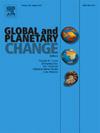Maastrichtian-Cenozoic erosional history of the northern Peruvian Amazonian Andes implications for the Eastern Cordillera evolution (Huallaga Basin, northern Peru)
Abstract
Late Cretaceous-Cenozoic Andean mountain building may have experienced various phases of orogenesis in response to variations the dip angle of the subducting slab, distinct magmatic pulses, and shortening rates of the orogen. The timing of the Eastern Cordillera (EC) erosion and the relationship between the Andean orogenesis and the establishing of the transcontinental Amazon River remains unclarified. The erosional history of the Amazon Andes and the timing of these orogenic events may be revealed by the late Cretaceous-Cenozoic sedimentary record of the Amazonian retroarc foreland basin. We investigate the provenance of the Maastrichtian-Cenozoic deposits of the Huallaga Basin based on major and trace elements concentrations, SmNd isotopic composition, and U
Pb zircon dating. We also refined the Oligocene paleoenvironment and calculated Paleogene sedimentation rates. Our results show that despite the 25 Myr-long sedimentary hiatus, both the Maastrichtian and Eocene units show dominant sourcing from the magmatic arc of the Western Cordillera (WC). Increases in Paleozoic and Famatinian zircon grains and a shift toward more negative ƐNd(0) values, indicate dominant EC sources during the Oligocene to middle Miocene. This change in provenance area is Rupelian in age based on the Maximum Likelihood Age (MLA) of JUA22 (29.70 ± 0.62 Ma), suggesting that the onset of Peruvian EC erosion started at ∼30 Ma. The erosion of the EC was accompanied by an increase in sedimentation rates and the development of a meandering fluvial system. Finally, a substantial decrease in zircon grains derived from the Cretaceous and Cenozoic Andean arcs from late Miocene to Recent sediments suggests no contribution of the WC. In contrast, an increase in Paleozoic magmatic arc zircon grains indicates sources in the EC. We compare our findings to constrain the erosional history of the Amazonian Andes and investigate the relationship between the timing of EC uplift and the onset of the transcontinental Amazon drainage system during the Cenozoic.

 求助内容:
求助内容: 应助结果提醒方式:
应助结果提醒方式:


